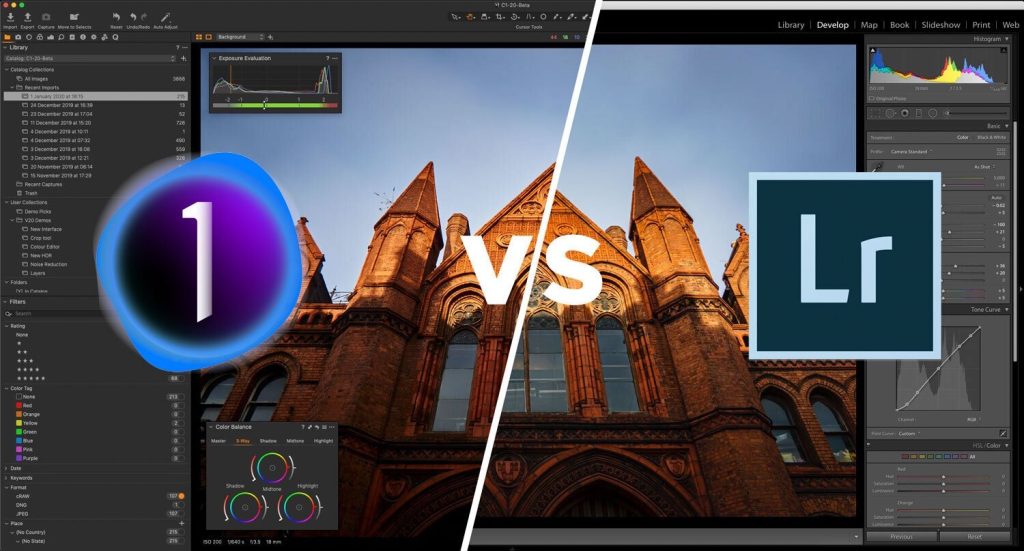Photo editing has become an integral part of the creative process for photographers, and choosing the right software can significantly impact the outcome of your images. In this guide, we’ll explore the distinctions between two prominent photo editing tools: Adobe Lightroom and Capture One.
Introduction
The world of photo editing software is vast, with numerous options catering to various needs. Selecting the right tool is crucial for achieving your desired results and streamlining your workflow.
Lightroom: Unveiling the Basics
Introduction to Adobe Lightroom
Adobe Lightroom stands as a stalwart in the photo editing realm, renowned for its comprehensive set of features and seamless integration with the Adobe Creative Cloud. It caters to a broad spectrum of users, from beginners to seasoned professionals.

Features and functionalities
Lightroom boasts a myriad of features, including non-destructive editing, advanced color grading, and a vast library of presets. Its cloud-based storage ensures accessibility across multiple devices, offering a flexible and convenient editing experience.
User-friendly interface
One of Lightroom’s standout features is its user-friendly interface. The software is designed to be intuitive, making it accessible to photographers at all skill levels. The organized layout enhances navigation and contributes to a smooth editing process.
Capture One: A Closer Look
Overview of Capture One
Capture One has gained prominence for its powerful image processing capabilities, catering to professional photographers and enthusiasts alike. Developed by Phase One, it is known for its exceptional color grading and tethering capabilities.
Distinctive features and capabilities
Capture One distinguishes itself with its advanced color grading tools, providing precise control over color adjustments. The software’s tethering capabilities make it a preferred choice for studio photographers, ensuring a seamless connection between the camera and computer.
Interface and usability
Capture One’s interface is tailored for efficiency, offering customizable workspaces to suit individual preferences. While it may have a steeper learning curve than Lightroom, the robust set of features appeals to users seeking more in-depth control over their editing process.
Pricing and Licensing
Cost comparison between Lightroom and Capture One
One significant consideration for users is the cost associated with each software. Lightroom operates on a subscription-based model, while Capture One follows a perpetual licensing model. Understanding the pricing structure is essential for users with budget constraints.
Licensing models and subscription options
Lightroom’s subscription model provides users with regular updates and access to the Adobe Creative Cloud ecosystem. Capture One’s perpetual licensing model allows users to purchase a version outright, with the option to upgrade for additional features.
Value for money considerations
Determining the value for money involves weighing the features, support, and frequency of updates against the cost. Both Lightroom and Capture One offer unique advantages, and the choice depends on individual preferences and requirements.
User Experience
Feedback and reviews on Lightroom
Lightroom enjoys widespread popularity, with positive feedback regarding its user-friendly interface, regular updates, and extensive feature set. The large user community contributes to a wealth of tutorials and support resources.
User sentiments towards Capture One
Capture One has a dedicated user base that appreciates its advanced color grading, tethering capabilities, and efficient workflow. While some users may find the learning curve challenging, others value the depth of control it provides.
Community support and engagement
Community support plays a crucial role in enhancing the user experience. Lightroom’s extensive user community results in a wealth of third-party resources, forums, and tutorials. Capture One’s community, while smaller, is known for its active engagement and collaborative spirit.

Editing Capabilities
Image processing in Lightroom
Lightroom’s image processing capabilities are comprehensive, offering a range of tools for basic adjustments, retouching, and creative enhancements. Its seamless integration with Adobe Photoshop further expands its editing capabilities.
Capture One’s approach to photo editing
Capture One focuses on delivering precise and nuanced color grading, making it a preferred choice for photographers who prioritize color accuracy. The software’s advanced tools cater to users seeking meticulous control over their editing process.
Feature-specific comparison
Comparing specific features, such as cataloging, export options, and local adjustments, provides insights into the strengths of each software. Understanding these nuances is essential for users with specific editing requirements.
Workflow and Efficiency
Workflow integration in Lightroom
Lightroom’s integration with the Adobe Creative Cloud facilitates a seamless and connected workflow. The ability to synchronize edits across devices enhances efficiency for photographers on the go.
Efficiency and speed considerations in Capture One
Capture One Pro is recognized for its speed and efficiency, particularly in handling large catalogs and high-resolution images. The software’s responsiveness contributes to a smooth editing experience, especially for those working in a studio environment.
Impact on user experience
The impact of workflow and efficiency on the user experience cannot be understated. Lightroom’s interconnected ecosystem and user-friendly interface appeal to those seeking a straightforward and efficient editing process. Capture One’s efficiency and control may be more attractive to users who prioritize a detailed and customized approach.
Pros and Cons
Advantages of using Lightroom
- User-friendly interface
- Seamless integration with Adobe Creative Cloud
- Large user community and support
- Regular updates and feature enhancements
Strengths and weaknesses of Capture One
- Advanced color grading capabilities
- Efficient tethering for studio photographers
- Steeper learning curve
- Smaller user community compared to Lightroom
Choosing the right software based on individual needs
The choice between Lightroom and Capture One ultimately depends on individual preferences, budget considerations, and specific editing requirements. Lightroom offers a more accessible and integrated experience, while Capture One provides in-depth control for users who demand precision in their edits.
Case Studies
Real-world applications of Lightroom
Case studies illustrate how Lightroom caters to various real-world scenarios, showcasing its versatility in portrait retouching, landscape enhancement, and other photographic genres.
Success stories and experiences with Capture One
Capture One’s success stories highlight the software’s role in professional photography, demonstrating its efficacy in achieving exceptional color grading and image quality.
User testimonials and insights
Personal testimonials from Lightroom and Capture One users provide valuable insights into their editing journeys. Understanding real user experiences can assist potential users in making informed decisions based on their editing goals.
Updates and Future Developments
Adobe Lightroom’s recent updates
Lightroom’s commitment to staying at the forefront of photo editing is evident in its regular updates. Users can expect enhanced features, improved performance, and compatibility updates that ensure a seamless editing experience.
Capture One’s commitment to innovation
Capture One’s commitment to innovation is reflected in its ongoing development and updates. The software’s roadmap includes exciting features and improvements, making it a compelling choice for users who appreciate cutting-edge developments.
Predictions for the future of photo editing software
As technology advances, the future of photo editing software looks promising. Both Lightroom and Capture One are likely to evolve, catering to the changing needs of photographers. Predicting future trends helps users stay ahead of the curve and make informed decisions about their preferred editing tools.
Conclusion
In the realm of photo editing, the choice between Lightroom and Capture One is subjective and depends on individual preferences. While Lightroom offers a more straightforward and integrated experience, Capture One provides a customizable and powerful alternative. Consider your budget, editing needs, and desired workflow to make an informed decision that aligns with your creative vision.
Frequently Asked Questions
Which software is better for professional photographers?
The choice between Lightroom and Capture One for professional photographers depends on individual preferences and specific editing requirements. Lightroom’s user-friendly interface and integration may appeal to some, while Capture One’s advanced color grading and tethering capabilities may be preferred by others.
How does the cost of Lightroom and Capture One compare?
Lightroom operates on a subscription-based model, while Capture One follows a perpetual licensing model. Users should evaluate their budget and the value offered by each software to determine the most cost-effective option for their needs.
Can Capture One compete with Lightroom’s user community and support?
Capture One has a smaller user community compared to Lightroom, but it is known for its active engagement and collaborative spirit. Users seeking a strong community connection should consider the size and nature of each software’s user base.
Is there a significant difference in the learning curve between Lightroom and Capture One?
Yes, there is a noticeable difference in the learning curve between Lightroom and Capture One. Lightroom’s user-friendly interface makes it more accessible to beginners, while Capture One’s extensive features may require a steeper learning curve.
What sets Capture One apart in terms of color grading?
Capture One is renowned for its advanced color grading capabilities, providing precise control over color adjustments. Photographers who prioritize accurate and nuanced color reproduction often find Capture One to be a superior choice.
